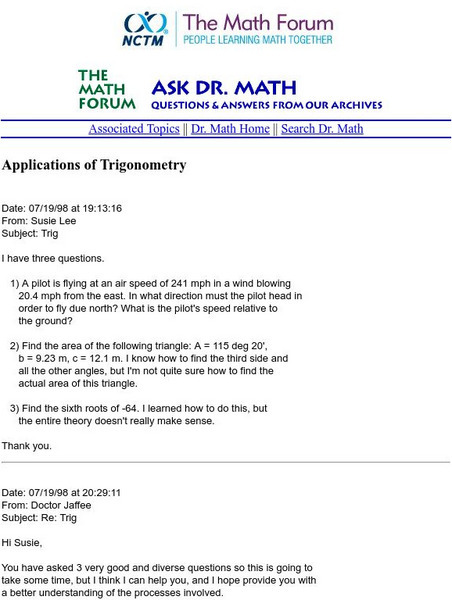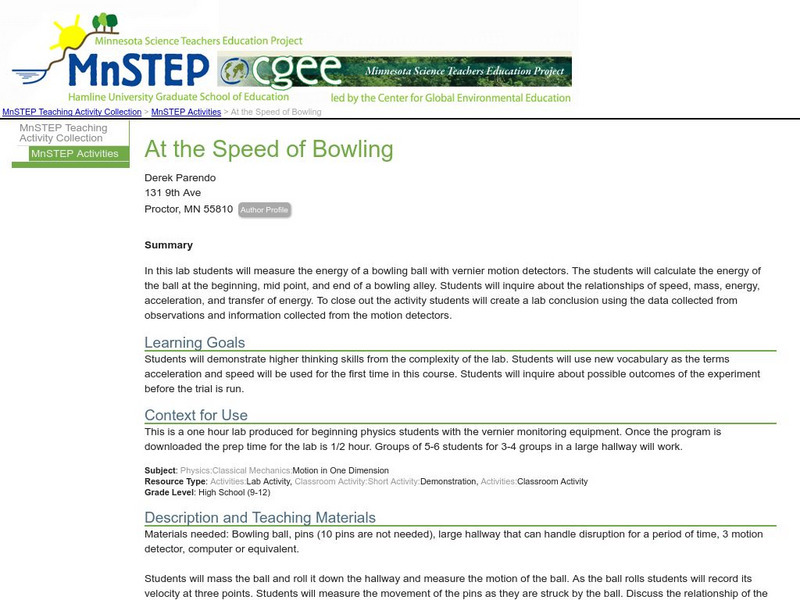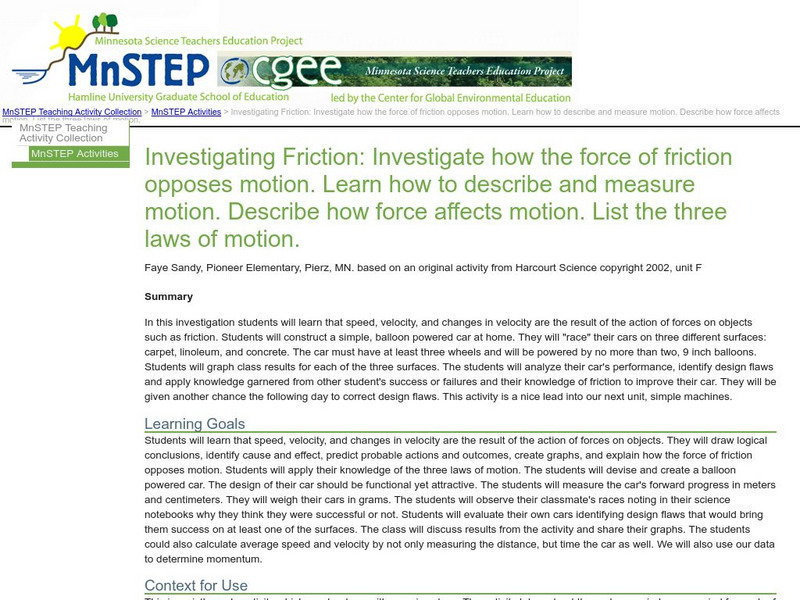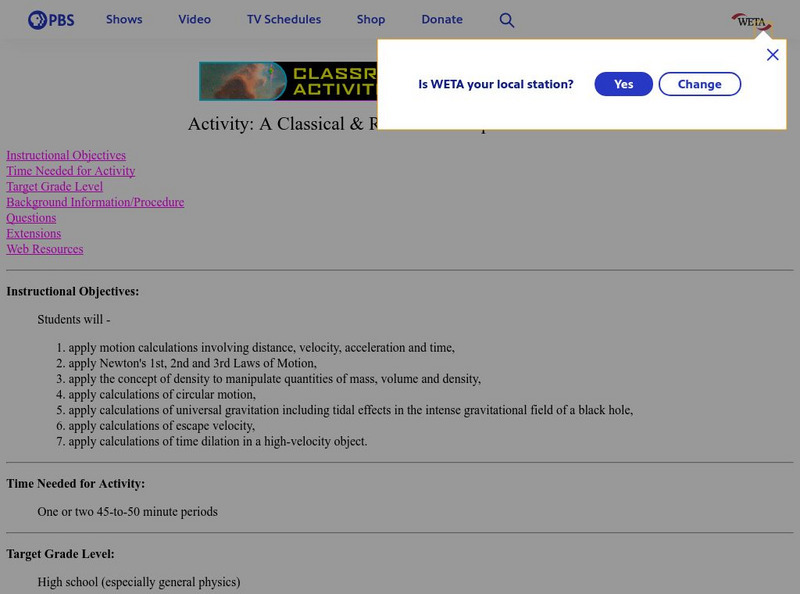Hi, what do you want to do?
Utah Education Network
Uen: Trb 3:3 Investigation 4 Collision Zone
Learn how forces of push and pull can change speed or direction.
Other
Uss Constitution Museum: How to Be a Great Navigator!
In this instructional activity, 7th graders are shown how Great Navigators of the past stayed on course with the historical methods of navigation. The concepts of dead reckoning and celestial navigation are discussed. Using Vector Voyage...
Open Ed
Open Ed Sci: 8.1 Contact Forces
In this unit, students explore a variety of phenomena to figure out, "Why do things sometimes get damaged when they hit each other?" Student questions about the factors that result in a shattered cell phone screen lead them to...
Georgia State University
Georgia State University: Hyper Physics: Traveling Wave Relationship
Online physics text that illustrates and explains the various characteristics of waves such as amplitude, period, frequency, wavelength, and speed. Includes interactive exercises.
Georgia State University
Georgia State University: Hyper Physics: Speed of Sound
Physics tutorial on measuring the speed of sound in dry air. An interactive form allows the student to practice solving problems involving the temperature dependence of the speed of sound.
E-learning for Kids
E Learning for Kids: Science: Antarctica: Penguins: What Is Motion?
What do you know about Emperor penguins? Ernie is researching them and their migration across the continent.
University of Utah
University of Utah: Dept. Of Mathematics: Physics of Skiing
Do you like to ski? If you do, do you ski for the physical sport of it? This resource turns the attention to the mathematical side of the winter sport.
National Council of Teachers of Mathematics
The Math Forum: Ask Dr. Math: Applications of Trigonometry
Dr. Math answers a word problem involving the use of vectors.
Texas Instruments
Texas Instruments: What's Your Speed?
In this activity, students' will use a motion detector to determine what effect the speed at which a person moves has on the appearance of the distance versus time plot.
Texas Instruments
Texas Instruments: Cas Your Girl Friend
In this activity, students find the time a man takes to catch a moving train. They solve the problem with and without using calculus.
Texas Instruments
Texas Instruments: Numb3 Rs: Up to Speed
Based off of the hit television show NUMB3RS, this lesson builds upon the familiar d=rt formula for distance to include elements of acceleration as well. The lesson is framed in the context of traffic flow theory, but makes some very...
Texas Instruments
Texas Instruments: How Incline Affects Speed
Students determine how incline affects speed. They will communicate their results graphically.
Science Education Resource Center at Carleton College
Serc: At the Speed of Bowling
In this lab students will measure the energy of a bowling ball with vernier motion detectors. The students will calculate the energy of the ball at the beginning, mid point, and end of a bowling alley. Students will inquire about the...
Science Education Resource Center at Carleton College
Serc: Investigating Forces: Pop Bottle Rockets
In this lab, students will work on scientific inquiry skills: observation, developing questions, conducting an experiment, and collecting data. They will investigate forces using pop bottle rockets that they have designed.
Science Education Resource Center at Carleton College
Serc: Investigating Speed and Constant Acceleration
Students roll miniature cars down a ramp and measure their speed and acceleration every 10 cm. Students can vary the type of car, height of ramp or the ramp material. Student change one of these variables to investigate how the car's...
Science Education Resource Center at Carleton College
Serc: Using Velocity and Acceleration Vectors to Interpret the Motion of a Car
Students understand that vectors have both magnitude and direction components as they investigate velocity and acceleration vectors.
Science Education Resource Center at Carleton College
Serc:investigating Friction:investigate How the Force of Friction Opposes Motion
In this investigation, students will learn that speed, velocity, and changes in velocity are the result of the action of forces on objects such as friction. They will be able to explain how the force of friction opposes motion by...
Science Education Resource Center at Carleton College
Serc: Motion: Investigating Motion Graphs
For this lesson, students investigate motion graphs. Students predict what the distance-time graph and velocity time graph would look like for a student walking across the room for three different scenarios.
Science Education Resource Center at Carleton College
Serc: Experiment Problem in Kinematics: How Much Does It Take to Win the Race?
Students are presented with two cars that have different constant speeds and that will race each other. They then determine which object will win the race, as well as how much time elapses between the objects crossing the finish line.
Wikimedia
Wikipedia: The Black Hole
This site examines the black hole as an object in astrophysics. Delve into this comprehensive resource that covers this concept from its history, to qualitative physics, the reality of black holes, mathematical physics and more.
E-learning for Kids
E Learning for Kids: Science: Bay of Whales: Calculating Speed
Amelia is a researcher. She studies the speed of animals. Join her in Antarctica to help her figure these calculations.
PBS
Pbs: A Classical and Relativistic Trip to a Black Hole
This PBS site is a classroom activity that takes a trip to a black hole. Learners apply calculations on distance, velocity, acceleration, time, circular motion, density, and more.
Other
Calculus Preview
The resource gives students a preview of topics learned in Calculus. Concepts included are graphs, speed, and integration. Graphs, tables, and an interactive applet are used to investigate the examples.
Other
Sprk: Time, Speed, and Distance:teacher Guide [Pdf]
Students will use Sphero to show that there is a linear relationship between time, speed, and distance. They will program Sphero to move at a particular speed for a particular amount of time, and then measure how far it has gone.They...

























